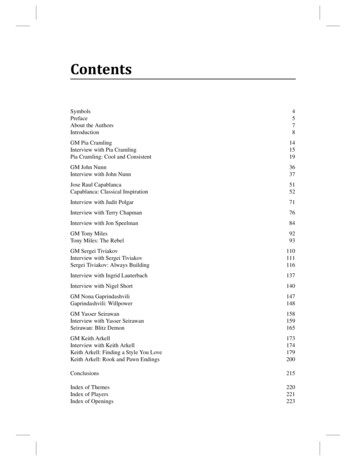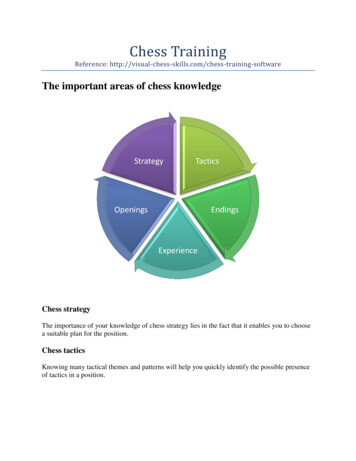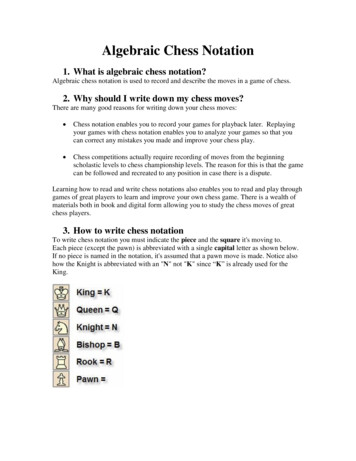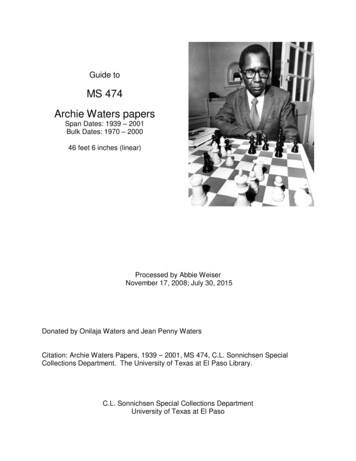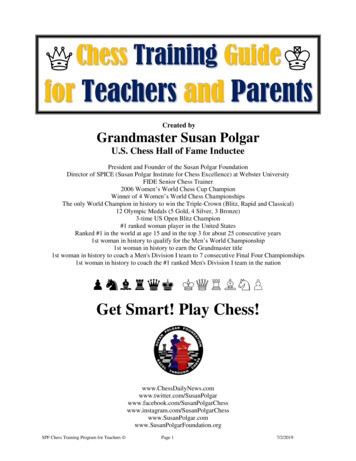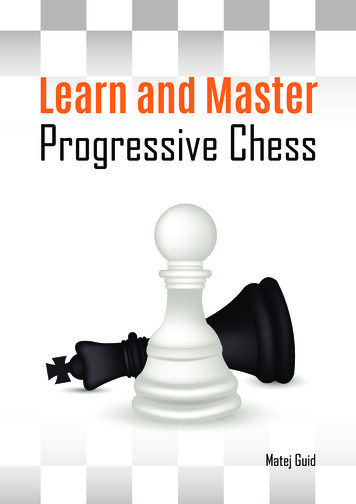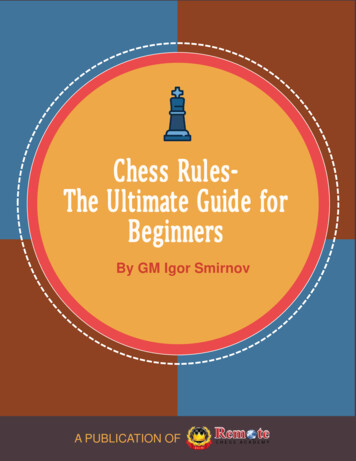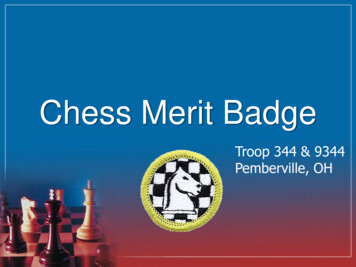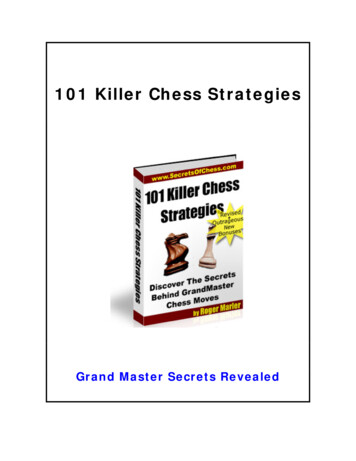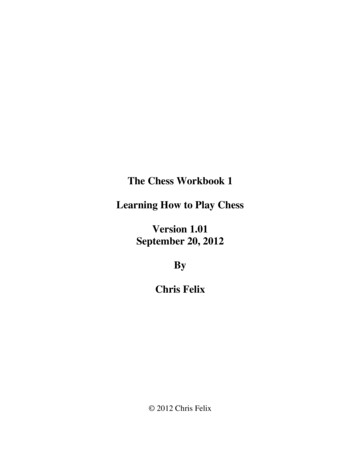
Transcription
The Chess Workbook 1Learning How to Play ChessVersion 1.01September 20, 2012ByChris Felix 2012 Chris Felix
IntroductionThis workbook has been created as a self training guide for learning how to play chess. This firstworkbook deals with the rules of the game and is intended to get the student familiar with the game andable to play a game of chess.By the end of this workbook the student should be confident that they understand the rules of the gameand can complete a game of chess with family and friends.As an expert level player, and someone who has been teaching chess for a number of years, I hopeeveryone that uses this free training guide will find it interesting and useful.For anyone wishing to use this material as a teaching resource in a school, library or group, they aremore than welcome to use this guide to assist and help others learn how to play chess!I welcome all feedback and comments. Feel free to e-mail me at chrisfelix1337@hotmail.com.-Chris FelixPage 1/29The Chess Workbook 1Version 1.01
The BoardThe first thing to learn about chess is the board. This is the playing field that all the pieces will movethrough and be limited to.The chessboard is an 8-by-8 grid for a total of 64 squares consisting of two types of squares, lightsquares and dark squares, which are generally black and white. Chessboards appear with letters andnumbers on the board for the ease of describing parts of the chess board.When setting up a chessboard, the right-most corner square should be a light square. You can rememberthis with an easy saying, “white in the right”.With the diagram above we can see that the light square is in the right hand corner, and letters arerunning left to right across the board and the numbers are running up and down the board.If you have a chessboard that is not numbered and lettered, it would be helpful to label your board asshown in the diagram as you progress through this workbook. Practicing all of the lessons and problemson a real board will benefit you more than just looking at the 2D board diagrams.Page 2/29The Chess Workbook 1Version 1.01
On the chessboard the lettered columns are called files. Every square that falls in the “a” column isreferred to as the “a file”. The numbered rows are called ranks. Every square that falls in the “4” rowis called the “4th rank”. The diagrams below demonstrate this idea and highlights the squares.The “d file” is highlightedThe “3rd rank” is highlightedLetters for parts of the chessboard are always written or referred to in lower case letters, never capitals.When we want to refer to a specific square on the chessboard, we first look at the file the square belongsto, followed by the rank the square belongs to and merge those into a single letter-number combination.For example, a square that belongs to the g file and the 6th rank is called the g6 square. Notice how theletter is lower case and appears first, followed by the number.This square belongs to the g file and 6th rankPage 3/29The Chess Workbook 1It’s the g6 square!Version 1.01
Diagonals also are named in chess, as they also play an important role on the board. When we referencea diagonal we use the starting and ending squares along that diagonal.The image to the left shows the a1-h8 diagonal. This isbecause the diagonal starts at the a1 square and ends onthe h8 square.Generally we use the bottom-most square of the diagonalas the “starting point” but this is not a strict rule. Manypeople will also call this the h8-a1 diagonal!Below are two more examples of the naming for diagonals.The d1-a4 diagonal! (or a4-d1)Page 4/29The Chess Workbook 1The a4-e8 diagonal! (or e8-a4)Version 1.01
Exercise 1Now it’s time to try it yourself! Below each diagram write in what the area of the board is named.1.2.3.4.Page 5/29The Chess Workbook 1Version 1.01
Exercise 1 Answers1. The 7th Rank2. The c File3. The e4 Square4. The g1-a7 Diagonal (or a7-g1)Don’t forget that when referring to parts of the chessboard the letters are always lower case!Page 6/29The Chess Workbook 1Version 1.01
Moving the PiecesWhen you move a chess piece, you pick up the piece and place it down on a different square that thepiece can legally move to.You may never move a piece to a square that is already occupied by one of your own pieces.When you move one of your pieces to a square that is occupied by one your opponent’s pieces, theopponent’s piece is removed from the board, and your piece is now placed on that square. This is calledcapturing your opponent’s piece.If a chess piece could capture an opposing piece the very next turn, that piece is said to be attacking theopposing piece.Touch Move RuleChess is a game of visualization and thinking; the following rules are generally applied to chess games,but are not always enforced: When you touch one of your pieces, you must move that piece if it can be legally movedWhen you touch one of your opponent’s pieces, you must capture that piece if it can be legallycapturedYou complete all of your chess moves with a single hand (including hitting your clock, if a clockis being used)Page 7/29The Chess Workbook 1Version 1.01
The PiecesThe RookMeet the rook, the piece that resembles a castle tower. Your chess set will have two white rooks andtwo black rooks.The rook may move any number of squares you want left or right across a rank or up and down along afile, but may not go through any other pieces.The rook can move any number of squaresThe rook can capture the white piece!Page 8/29The Chess Workbook 1The rook can’t go through other pieces!The piece is captured!Version 1.01
The BishopThe bishop is one of the more interesting pieces in chess; generally the piece looks like a hat with a littleball on the top and may have a slit cut into the side of the piece. Your chess set will have two whitebishops and two black bishops.The bishop may move any number of squares you want diagonally, but may not go through any otherpieces.The bishop can move any number of squaresThe bishop can’t go through other pieces!Because the bishop can only move diagonally, this means a bishop that starts on a light square will onlyever be able to move on light squares. The bishops are named the light squared bishop and darksquared bishop.Page 9/29The Chess Workbook 1Version 1.01
The QueenThe queen is the most powerful piece in chess; it is a combination of the rook and bishop! Your chessset will generally have one white queen and one black queen. Some chess sets come with multiplequeens to use as spares. The queen will be one of the tallest pieces and have a pointy crown on the topof the piece.The queen may move any number of squares you want left or right across a rank, up and down along afile or diagonally, but may not go through any other pieces.The queen can move any number of squaresPage 10/29The Chess Workbook 1The queen can’t go through other pieces!Version 1.01
The KingThe king is the most important piece in chess as we will learn later. Your chess set will have one whiteking and one black king. The king generally be the tallest piece and have a cross on his head.The king can only move one square in any direction.Page 11/29The Chess Workbook 1Version 1.01
The KnightThe knight is an unusual piece, as it’s the only piece in chess that can “jump” over other pieces. Yourchess set will have two white knights and two black knights. The knight will generally look like a horse.The knight moves in the shape of an “L” and goes directly from the square it is on to the square you aremoving it to, this means it can jump over any piece in between those two squares. To find all of thesquares a knight can move to you must count two squares in a direction, followed by a single square inan adjacent position from the square the knight is on. For example, you can count two squares “up” andthen one square to the “left”, the following diagram will make this easier to visualize.Counting out the squares for possible movesThe squares the knight can move toKnights can jump over other pieces!Page 12/29The Chess Workbook 1Version 1.01
The PawnThe pawns are very unique and often thought of as weak, this couldn’t be further from the truth! Yourchess set will have eight white pawns and eight black pawns.The pawn can only move one square forward if that square is unoccupied by any other piece. A pawncan only capture an opposing piece one square diagonally. A pawn is the only piece that can nevermove backwards!The pawn can only move one square forwardThe pawn can only capture one squarediagonallyIf a pawn has not been moved in the game yet, that pawn is allowed to move either one or two squaresforward for it’s first move.Page 13/29The Chess Workbook 1Version 1.01
Exercise 2Write the name of the piece in the space provided beside the picture.1.2.3.4.5.6.7. What is the only piece in chess that may not ever move backwards?8. The Queen is the combination of which two pieces?9. Which is the only piece in chess that can jump over other pieces?Page 14/29The Chess Workbook 1Version 1.01
Count how many squares the pieces can legally move to in the diagrams given.10. White Bishop:12. Black Rook:11. White Knight:13. Black King:14. White Rook:15. Name each of the squares in the position below that the knight can move to.List the Squares:Page 15/29The Chess Workbook 1Version 1.01
Exercise 2 AnswersWrite the name of the piece in the space provided beside the picture.1. The Queen2. The Bishop3. The Knight4. The Rook5. The Pawn6. The King10. What is the only piece in chess that may not ever move backwards?The pawn! It can never move backwards, only forward while moving and capturing.11. The Queen is the combination of which two pieces?The Rook and the Bishop.12. Which is the only piece in chess that can jump over other pieces?The Knight.Page 16/29The Chess Workbook 1Version 1.01
Count how many squares the pieces can legally move to in the diagrams given.10. White Bishop: 7 (a8, c6, d5, e4, f3, a6, c8)11. White Knight: 4 (e1, e3, f4, h4)12. Black Rook: 6 (a2, a3, a4, b1, c1, d1!) Don’t forget that you can capture the rook on d1!13. Black King: 5 (a6, b6, b5, b4, a4)14. White Rook: 14!! (a1! b1, c1, e1, f1, g1, h1, d2, d3, d4, d5, d6, d7, d8)15. Name each of the squares in the position below that the knight can move to.a4, a6, b7, d7, e6, e4, d3, remember you can’t land on your own piece!Page 17/29The Chess Workbook 1Version 1.01
The Object of the GameTo win a game of chess you need to trap your opponent’s king.CheckWhen the king is being attacked by a piece, the king is said to be “in check”. When a player moves apiece to attack the king, that player announces “check” to the opponent.When a king is in check, that player must make a move so that the king is not in check at the end of theturn. This also means that the king cannot move into check. There are three ways that a player can getout of check, they are: Move the king, so that the king is not in checkCapture the checking piece, so that the king is not in checkBlock the checking piece, so that the king is not in checkYou can remember these three things with an easy saying, “Move, Take or Block!”The black king is in check by the bishop on b4!Black can move the king to e8 or f7(e7 is still attacked by b4 bishopg7 and g8 are attacked by the g2 rook)Black can take the bishop on b4 with theknightBlack can block the check by moving knightto e7CheckmatePage 18/29The Chess Workbook 1Version 1.01
If a king is currently in check, and cannot make a legal move to get the king out of check by moving,taking, or blocking, then the king is said to be in “checkmate”. The game is over, and the checkmatedside loses the game.To decide if a position is checkmate, you must ask yourself the following questions:1.2.3.4.Is the king currently in check?Can the king move out of check?Can you capture the piece to escape check?Can you block the piece to escape check?If the king is currently in check, and the answer to the other questions is no, then the position ischeckmate.1. Is the king currently in check?Yes, by the queen on e71. Is the king currently in check?Yes, by the rook on h42. Can the king move out of check?Yes, the king can move to g8(e8, f7, g7 still attacked by the queen)2. Can the king move out of check?No, all squares are covered by the rooks3. Can you capture the piece to escape check?No, because the king would still be in check bythe pawn on d6!3. Can you capture the piece to escape check?No, no piece can capture the rook on h44. Can you block the piece to escape check?No, there are no pieces to block4. Can you block the piece to escape check?No, the knight cannot block the rook on h4The position is not checkmate; the King can moveThe position is checkmate!StalematePage 19/29The Chess Workbook 1Version 1.01
If a player cannot make any legal move on their turn and they are not currently in check, the game iscalled a draw by stalemate.White can’t move anywhere! The game is a draw!Starting a GameWhen setting up a chess board, white sets their pieces up on ranks 1 and 2, while black sets their piecesup on ranks 7 and 8.Along the back rank both players setup their pieces in the following positions: The two rooks are setup on the outside corners of the board.The two knights are setup on the next square towards the center beside the rooks.The two bishops are setup on the next square towards the center beside the knights.The queen goes on her own color (white queen on the white middle square, black queen on theblack middle square).The king goes on the last available square on the back rank.The pawns are all placed on the next rank in front of the other pieces.Page 20/29The Chess Workbook 1Version 1.01
Exercise 3Indicate below each position whether the position is Check, Checkmate, Stalemate, or nothing.1.3.Page 21/29The Chess Workbook 12.4.Version 1.01
5.Page 22/29The Chess Workbook 16.Version 1.01
Exercise 3 AnswersPosition 1:Check!The king is in check by the white rook on d8, however it is not checkmate because the king can legallymove to h7.Position 2:StalemateThe king is not currently in check, and black has no legal moves on the board. The position is a draweven though white has a queen and black has only a king!Position 3:Nothing!!The king is not in check, but black can legally move his knight so the position is not a stalemate eventhough the black king cannot legally move.Position 4:CheckmateThe white king is checkmated. He has no squares to legally move, he cannot capture the black queenbecause of the bishop on c6.Position 5:CheckThis position is only check, as the white queen can capture the rook on h1. After this capture the whiteking will not be in check.Position 6:CheckThis one is tricky, but black can block the check with the rook! Moving black rook to f8 will block thecheck from the white rook.Page 23/29The Chess Workbook 1Version 1.01
Special MovesThere are three special moves in chess, castling, en passant, and pawn promotion.CastlingCastling is a special move where the king and a chosen rook are both allowed to move in the same turn.To perform castling, you choose a rook and then move the king two squares towards the chosen rookand then the chosen rook is placed directly on the other side of the king. You may perform castling ifthe following criteria are met: The king has not previously movedThe chosen rook has not previously movedThere are no pieces between the king and the chosen rookThe king is not currently in checkThe king does not pass through a square that is being attacked by an enemy pieceThe king does not end up in check after castlingPlayers can castle both kingside (with the chosen rook on the h file) and queenside (with the chosen rookon the a file).You can castle either side!Page 24/29White castled kingside.The Chess Workbook 1White castled queenside.Version 1.01
Rules 4, 5 and 6 can easily be remembered by the following saying: “Can’t castle while in check,through check or into check”.Can’t castle while in check!Can’t castle through check!Can’t castle into check!Pawn PromotionWhen a pawn reaches the final rank (8th rank for white, 1st rank for black) then the pawn can be replacedby a knight, bishop, rook or queen. This is called a promotion. The player who is promoting the pawnchooses which piece that pawn promotes to.The pawn is about to reach the last rank!Page 25/29The pawn promotes to a queen on c8!The Chess Workbook 1Version 1.01
En PassantThe last special move in chess is called “en passant”, which is French for “in passing”. This specialmove only occurs when a player chooses to move a pawn two squares forward, and that pawn ends upon a square that is directly beside an enemy pawn.When these two criteria have been met, the opposing player may capture the pawn as if the pawn onlymoved one square. The opposing player may only do this on their next move; otherwise the en passantrule is no longer in effect.For example, if the black pawn was moved from e7 to e5, while there was a white pawn on d5, onwhite’s very next move he may place his pawn on e6, and capture the pawn that is on e5.If the black pawn moves to the e5 square, both conditions are met for en passant. The pawn hasmoved two squares, and the pawn is now directly beside an opposing pawn.White captures the pawn en passant!Page 26/29The Chess Workbook 1Version 1.01
Exercise 4For each position, can white legally castle?1.2.3.4.Page 27/29The Chess Workbook 1Version 1.01
5. A few turns ago in the following position black moved his pawn from d7 to d5. Can white now takeen passant on d6?YesNo6. In the following position black has just played pawn from h7 to h5. Can white now take en passanton h6?YesNo7. Which rank must a black pawn reach in order to promote?8. What are all the possible pieces that a pawn can promote to?Page 28/29The Chess Workbook 1Version 1.01
Exercise 4 AnswersPosition 1:White cannot castle because after doing so the white king would be in check by the black rook on g6Position 2:White can castlePosition 3:White can castlePosition 4:White cannot castle because the king would move through an attacked square. The d1 square is beingattacked by the black rook on d8.Position 5:White cannot take en passant as a few turns have already occurred since the pawn being moved twosquares. En passant must be taken right away.Position 6:White can take en passant by moving his pawn to h6, and removing the black pawn from h5.Question 7:Black pawns must reach the 1st rank in order to promote, while white pawn must reach the 8th rank.Question 8:Any pawn can promote to a Rook, Bishop, Knight or Queen.Page 29/29The Chess Workbook 1Version 1.01
Page 9/29 The Chess Workbook 1 Version 1.01 The Bishop The bishop is one of the more interesting pieces in chess; generally the piece looks like a hat with a little ball on the top and may have a slit cut into the side of the piece. Your chess set will have two white bishops and two black bishops.

